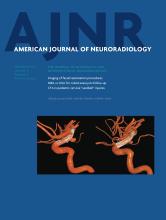Index by author
Jo, K.
- InterventionalYou have accessThromboembolic Complications in Patients with Clopidogrel Resistance after Coil Embolization for Unruptured Intracranial AneurysmsB. Kim, K. Kim, P. Jeon, S. Kim, H. Kim, H. Byun, J. Cha, S. Hong and K. JoAmerican Journal of Neuroradiology September 2014, 35 (9) 1786-1792; DOI: https://doi.org/10.3174/ajnr.A3955
Johnson, E.
- BrainOpen AccessQuantitative 7T Phase Imaging in Premanifest Huntington DiseaseA.C. Apple, K.L. Possin, G. Satris, E. Johnson, J.M. Lupo, A. Jakary, K. Wong, D.A.C. Kelley, G.A. Kang, S.J. Sha, J.H. Kramer, M.D. Geschwind, S.J. Nelson and C.P. HessAmerican Journal of Neuroradiology September 2014, 35 (9) 1707-1713; DOI: https://doi.org/10.3174/ajnr.A3932
Jollenbeck, B.
- BrainOpen AccessA Novel Technique for the Measurement of CBF and CBV with Robot-Arm-Mounted Flat Panel CT in a Large-Animal ModelO. Beuing, A. Boese, Y. Kyriakou, Y. Deuerling-Zengh, B. Jöllenbeck, C. Scherlach, A. Lenz, S. Serowy, S. Gugel, G. Rose and M. SkalejAmerican Journal of Neuroradiology September 2014, 35 (9) 1740-1745; DOI: https://doi.org/10.3174/ajnr.A3973
Jou, L.-D.
- InterventionalYou have accessEffect of Structural Remodeling (Retraction and Recoil) of the Pipeline Embolization Device on Aneurysm Occlusion RateL.-D. Jou, B.D. Mitchell, H.M. Shaltoni and M.E. MawadAmerican Journal of Neuroradiology September 2014, 35 (9) 1772-1778; DOI: https://doi.org/10.3174/ajnr.A3920
Jourdan, F.
- InterventionalYou have accessIntracranial Aneurysmal Pulsatility as a New Individual Criterion for Rupture Risk Evaluation: Biomechanical and Numeric Approach (IRRAs Project)M. Sanchez, O. Ecker, D. Ambard, F. Jourdan, F. Nicoud, S. Mendez, J.-P. Lejeune, L. Thines, H. Dufour, H. Brunel, P. Machi, K. Lobotesis, A. Bonafe and V. CostalatAmerican Journal of Neuroradiology September 2014, 35 (9) 1765-1771; DOI: https://doi.org/10.3174/ajnr.A3949
Juliano, A.F.
- Head & NeckYou have accessImaging Appearance of the Lateral Rectus–Superior Rectus Band in 100 Consecutive Patients without StrabismusS.H. Patel, M.E. Cunnane, A.F. Juliano, M.G. Vangel, M.A. Kazlas and G. MoonisAmerican Journal of Neuroradiology September 2014, 35 (9) 1830-1835; DOI: https://doi.org/10.3174/ajnr.A3943
Junewar, V.
- FELLOWS' JOURNAL CLUBBrainYou have accessNeuroimaging Features and Predictors of Outcome in Eclamptic Encephalopathy: A Prospective Observational StudyV. Junewar, R. Verma, P.L. Sankhwar, R.K. Garg, M.K. Singh, H.S. Malhotra, P.K. Sharma and A. PariharAmerican Journal of Neuroradiology September 2014, 35 (9) 1728-1734; DOI: https://doi.org/10.3174/ajnr.A3923
Imaging findings in 45 patients with eclampticposterior reversible encephalopathy syndrome were assessed. The most common affected areas were the occipital, parietal, frontal, and temporal lobes. Serum creatinine, uric acid, and lactate dehydrogenase values and presence of moderate or severe PRES were significantly associated with mortality. Eclamptic PRES demonstrated a higher incidence of atypical distributions and cytotoxic edema than previously thought.
Kallmes, D.F.
- FELLOWS' JOURNAL CLUBBrainYou have accessEarly Basal Ganglia Hyperperfusion on CT Perfusion in Acute Ischemic Stroke: A Marker of Irreversible Damage?V. Shahi, J.E. Fugate, D.F. Kallmes and A.A. RabinsteinAmerican Journal of Neuroradiology September 2014, 35 (9) 1688-1692; DOI: https://doi.org/10.3174/ajnr.A3935
These authors found that increased cerebral blood flow and volume were seen in the basal ganglia of 4.3% of patients with ischemic strokes with CT perfusion. All patients had underlying MCA occlusions, 30% underwent hemorrhagic transformations, and the hyperperfused areas eventually became infarcted in all. Thus, acute basal ganglia hyperperfusion in patients with stroke may indicate nonviable parenchyma.
Kang, G.A.
- BrainOpen AccessQuantitative 7T Phase Imaging in Premanifest Huntington DiseaseA.C. Apple, K.L. Possin, G. Satris, E. Johnson, J.M. Lupo, A. Jakary, K. Wong, D.A.C. Kelley, G.A. Kang, S.J. Sha, J.H. Kramer, M.D. Geschwind, S.J. Nelson and C.P. HessAmerican Journal of Neuroradiology September 2014, 35 (9) 1707-1713; DOI: https://doi.org/10.3174/ajnr.A3932
Kang, J.
- EDITOR'S CHOICEPediatricsYou have accessScreening CT Angiography for Pediatric Blunt Cerebrovascular Injury with Emphasis on the Cervical “Seatbelt Sign”N.K. Desai, J. Kang and F.H. ChokshiAmerican Journal of Neuroradiology September 2014, 35 (9) 1836-1840; DOI: https://doi.org/10.3174/ajnr.A3916
The authors investigated the significance of several clinical and imaging risk factors, most specifically the “cervical seatbelt sign,” in the anterior neck in pediatric patients with suspected blunt cerebrovascular injury as seen by CTA. They found that this common indication for neck CTA was not associated with blunt cerebrovascular injury. With the exception of Glasgow Coma Scale score, no single risk factor was statistically significant in predicting vascular injury.








